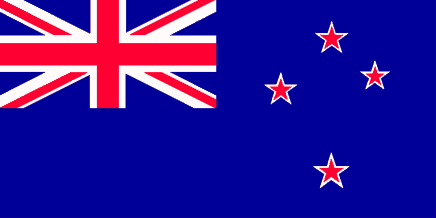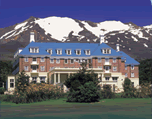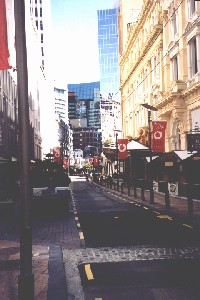
26 November 2002
After
breakfast with Warwick we take the car and drive to Wai-O-Tapu.
Here we first drive past a couple of vulcanic mud pools before we reach
the reception building. Here we buy our ticket. Then we do a self guided tour of
the area behind it along a number of vulcanic hot pools, who are joyfully
bubbling away their sulphuric fumes. It is a spectacular sight, but the
smell is less fun. We then drive back a half a mile to the Lady Knox Geyser
(same ticket). Here we have to take a seat in the "theatre" stands.
After a short while a park ranger steps in front of the crowd and pours a packet
of soap powder into the geyser's vent. A few minutes later the geyser starts to
release steam and water in a jet which initially plays at around 18m and then
continues at half height for about an hour. Naturally the geyser plays
every 48 hours, but the soap powder gives nature a hand so that she gives a
spectacular performance daily, promptly at 10.15am.
We drive back to Rotorua. We have lunch, send e-mail back home and
head for the Okere Falls Scenic Reserve. We walk up to the
Tautea Falls. A beautiful waterfall in dense forest. It's also white water
rafters' mecca. We see a few racing past. We return to the B&B.
We have tea with Michael, one of our hosts. We are picked up for
the Mia Ora
night, a cultural Maori spectacle with a buffet dinner at the end. The evening
starts with a Maori welcome ritual. A couple of warrior comes forward to check
out the visitors. When everything seems to be okay we are offered
a leaf or
branch, which should be picked by our "chief". Then we can come into
their ancestral home. This is followed by a speeck and songs after which the
concert starts. After
the concert there is opportunity to take pictures of the performers. The dinner
buffet with Maori food (a Hangi) is varied and fine. Then follows a
somewhat embarassing part of the evening: guests are asked by country to sing a
song in their own language. The evening is over by 9pm when we are granted a
last look at the Pohutu geyser at night. The geyser is illuminated and steaming,
but refuses to play. Warwick comes to collect us. Returned home we have a glass
of Merlot with him and Michael.
Rotorua - Whakapapa (Tongariro NP): 177km
After another fine cooked breakfast we leave in the direction of Taupo, waived off by our friendly host Warwick. Just north of Taupo we have a look at the Huka falls. It is not a very high waterfall but a nice sight, nevertheless. We drive through Taupo along the shores of the Lake of the same name. Lake Taupo - the largest in New Zealand - was created some 2000 years ago by a vulcanic outburst. Historians have been able to pinpoint the events to 186 AD, because the Chinese and even the Romans (!) noticed it and left records.
 We
continue to the Tongariro National Park and head for the Grand
Chateau in Whakapapa. As the road takes us higher the weather becomes worse.
It's foggy and there is a persistent drizzle. The hotel is superbly set at the
backdrop of snowtopped mountains. Our room is not ready yet so we have lunch in
the Hotel's café (cute waiter). We get some information on the walking
possibilities in the park at the neighbouring visitor centre. Tomorrow we want
to do the Tongariro Crossing. Now we settle for the very short Ridge
Track. It is still raining and it is a steepish walk. We are back in 50 minutes
and head back for the hotel, because the weather is getting worse and the view
is reduced to about 50m (55 yds). We spend some time in the hotel's sauna and
pool (a bit disappointing). Later at night we have dinner in the hotel's
restaurant, which is very good (New Zealand Lamb)
.
We
continue to the Tongariro National Park and head for the Grand
Chateau in Whakapapa. As the road takes us higher the weather becomes worse.
It's foggy and there is a persistent drizzle. The hotel is superbly set at the
backdrop of snowtopped mountains. Our room is not ready yet so we have lunch in
the Hotel's café (cute waiter). We get some information on the walking
possibilities in the park at the neighbouring visitor centre. Tomorrow we want
to do the Tongariro Crossing. Now we settle for the very short Ridge
Track. It is still raining and it is a steepish walk. We are back in 50 minutes
and head back for the hotel, because the weather is getting worse and the view
is reduced to about 50m (55 yds). We spend some time in the hotel's sauna and
pool (a bit disappointing). Later at night we have dinner in the hotel's
restaurant, which is very good (New Zealand Lamb)
.
28 November 2002
Today is the big day. We get up at 6.30, breakfast at 7. Then we
walk with a packed lunch and other essentials in our backpack to the visitor
centre. At 8 a bus leaves from here to the starting point of the Tongariro Crossing,
the Mangatepopo
car park. It is a vintage bus that takes us there cracking and protesting at
every slope. It is very foggy and we have no idea where are when we leave the
bus. We just start walking, following the poles marking the track. It starts
fairly easy. After an hour we reach Soda Springs. Now follows a very steep part
up to Mangatepopo Saddle between Mt Tongariro and Mt Ngauruhoe. It becomes very
tough and Erik is having a hard time. I take his backpack. The fog takes
away the view and it impossible to see how much more we have to climb. We can
see no further than the next pole. The climbing takes about an hour. Then the
mist clears and we have a magnificent view of Mt Ngauruhoe (which we had not
noticed until then). Even Mt Egmont near Auckland can be seen in the
distance. We arrive at the South Crater. We are now at ± 1600m (5250ft). Then
it is a flat walk over the bottom of the Crater
Another
steep climb follows up to the highest point of the day near Red Crater at 1886m
(6188ft). The air becomes thinner and the earth is hot at places due to
vulcanic activity. Sulphuric steam is released through vents in the vulcanic
mountain. The views are breathtaking. Snowtopped vulcanoes, blue lakes,
red mountain slopes... We start the descent and get to Emerald Lakes. Another
beautiful sight. Then another flat part over the bottom of the Red Crater, with
some snowy patches. Then our last climb up to Blue Lake. The scenery is
stunningly beautiful. Beyond compare and by far the most beautiful we have ever
seen! Then the track descends down to Ketetahi hut where we arrive around 2pm.
We have a rest here before we start our last leg to the Ketetahi car park.
Suddenly Erik misplaces his foot, sprains his ankle and also hurts his knee in a
fall. Now we have to descend very carefully. And descending is all we do for the
next hour or so. After our descent we arrive in a nice forest - but we have
other things on our mind - in which we go on for about 40 minutes (flat) until
we reach the car park
Just in time for the 5pm bus back. The injuries may have cost us an extra hour.
We are exhausted, but contented.
The bus takes us back to the hotel in 20 minutes. We take a much needed
shower a take a rest before we go down to the restaurant for dinner. It does not
take long before we go to bed to sleep it all off.
Whakapapa - Wellington: 344km (214mi)
29 November 2002
Our next destination is Wellington,
the capital of N![]() ew
Zealand. We have a long drive ahead of us
ew
Zealand. We have a long drive ahead of us . The distance as such is not so long,
but the roads do not allow for driving at great speed. In Wanganui we buy a
bandage and an ice-pack for Erik's ankle, which has swollen quite a bit. We drive
along the West Coast and arrive around 3pm at City
Life Appartments. We are pleasantly surprised by the accommodation. It is a
luxury appartment with two bedrooms a spacious living room and a fully equipped
kitchen. The washing machine and dryer are very handy too. We do our
washing and go for some shopping, as we are in the midst of Wellington's central
shopping area.
. The distance as such is not so long,
but the roads do not allow for driving at great speed. In Wanganui we buy a
bandage and an ice-pack for Erik's ankle, which has swollen quite a bit. We drive
along the West Coast and arrive around 3pm at City
Life Appartments. We are pleasantly surprised by the accommodation. It is a
luxury appartment with two bedrooms a spacious living room and a fully equipped
kitchen. The washing machine and dryer are very handy too. We do our
washing and go for some shopping, as we are in the midst of Wellington's central
shopping area.
Later
that evening we have dinner in
Shed 5 in the Queen's Wharf
harbour area. A revitalised dock, with restaurants and other night spots. The
food (Ostrich, Venison Rack) in this former warehouse (1888) is fine.
30 november 2002
Wellington is New Zealand's second city in size. It built around a
harbour against the hills. It has around 400,000 inhabitants and is therefore a
lot smaller than Auckland. It also has more character, as the city centre
has more of a colonial atmosphere than amorphic Auckland. For
us the most important attraction is the Museum of New Zealand,
or Te Papa Tongwarewa. In this new
building (1998) we find a very modern exhibition on all kinds of aspects of New
Zealand: nature, history, culture, immigration, Maori culture etc. The many
interactive displays make it all the more enjoyable. Among those is a
cottage in which you can feel the sensation of an earthquake. New Zealand is on
a fault line and the earth crust is relatively thin. Minor quakes take place all
the time and sometimes there is a big one (like in 1996). In January 2003 the
museum will show an exhibition dedicated to Lord of the Rings
We stay here until 3pm, when we take a taxi to the cable car. The cable car
takes us to a lookout close to the botanical gardens. It is a short ride up a
steep hill, stopping four times on the way. The cable car was opened in 1902,
was electrified in 1933 and the present Swiss cars came into service in 1978. It
is fantastic weather and the views are good. We hang around up there for while
and then take the cable car down again. We could have taken one of the walking
tracks down through the gardens back into the city and the parliamentary
district.
Instead I walk to the parliamentary district from the lower cable car station.
Here I find the old Government Builing (1876). It looks as if it is stone
building, but it is the second largest wooden building in the world. In the 19th
century this was the seat of the entire government, now it is home to the law
faculty of Victoria University. Across the street is the Beehive (1982).
This is now an office of part of the government. The building does indeed
resemble a beehive. Next to it is the neo-classical parliament
building
(1912-18) and next to that the parliamentary library (1899). The buildings are
metres away from a fault line and during a renovation in the 1990's the latest
techniques were installed to make the buildings earthquake proof. Across from
parliament is the Backbencher pub,
frequented by members of parliament and civil servants.
Back in the appartment we prepare for the evening.
We have dinner in the Icon restaurant
in the Te Papa museum. One of New Zealand's top restaurants with a harbour
view. Great food (Scallops, Venison fillet) and good wine (Deutz
Brut NV, Kemblefield Merlot) .
We then move on to a gay bar in the city centre (the only one). Pound/Sovereign
is a large pub with an even larger dance club next to it. We are a bit early -
the party clearly has not started yet. We are tired and call it a night.